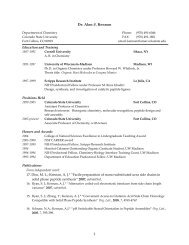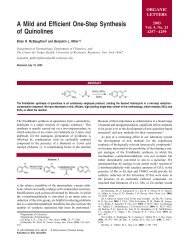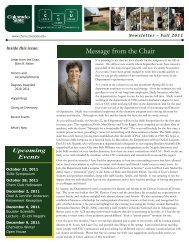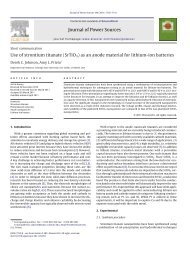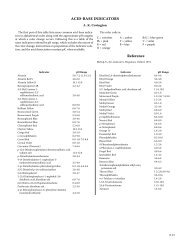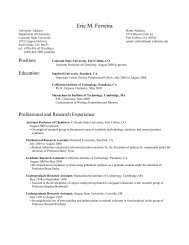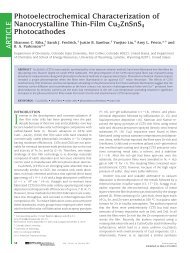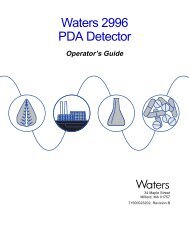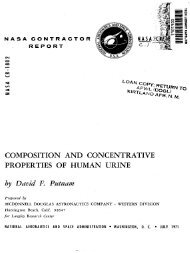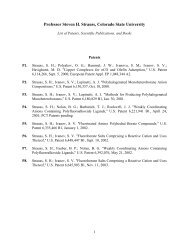Chemical Constitution and Reactivity. I. Phenyldiazonium Chloride ...
Chemical Constitution and Reactivity. I. Phenyldiazonium Chloride ...
Chemical Constitution and Reactivity. I. Phenyldiazonium Chloride ...
You also want an ePaper? Increase the reach of your titles
YUMPU automatically turns print PDFs into web optimized ePapers that Google loves.
June, 1940 DECOMPOSITION OF PHENYLDIAZONIUM CHLORIDES 1401<br />
coarse crystals. The product was filtered, washed by re-<br />
suspension twice in acetone <strong>and</strong> twice in ether. It was<br />
dried in air until free of ether <strong>and</strong> then in a desiccator until<br />
free of moisture. The yield was 3.5 g. All reasonable<br />
safety precautions were taken because of the highly ex-<br />
plosive nature of the product.<br />
The product was stored in a desiccator. In the dry<br />
state, no measurable decomposition occurred. The evolved<br />
nitrogen per gram remained constant. Each aliquot was<br />
weighed out <strong>and</strong> dissolved immediately prior to use.<br />
In order to justify the comparison of data ob-<br />
tained by use of crystalline diazonium chloride<br />
with those obtained by use of diazonium chloride<br />
solutions prepared by direct diazotization, two<br />
decomposition experiments, identical except as<br />
regards the method of preparation, were run. No<br />
difference in the rate data was found.<br />
Separate experiments were carried out at con-<br />
centrations ranging from a water-diazo ratio of<br />
1280:l (moles) to an extremely concentrated<br />
solution wherein the ratio was 2.36:l (moles).<br />
It was observed that for all concentration ratios<br />
the reaction followed the first order law. Data<br />
TABLE 11<br />
EFFECT OF CONCENTRATION ON THE REACTION VELOCITY<br />
CONSTANT AND YIELD OF PHENOL IN DECOMPOSITION OF<br />
PHENYLDIAZONIUM CHLORIDE SOLUTIONS, TEMP. 35 '<br />
Moles HrO/moles<br />
diazo k (sec-1) X IO5<br />
'% yield of<br />
phenol<br />
2.36 26.2 24.3<br />
3.11 26.8 30.0<br />
3.54 25.6 27.1<br />
3.94<br />
7.93<br />
26.7<br />
..<br />
31.4<br />
37.0<br />
11.89 25.3 40.0<br />
23.80 24.5 48.7<br />
31.70 23.9 58.5<br />
47.58 23.4 59.3<br />
79.30 21.9 78.0<br />
158.60<br />
317.20<br />
634.40<br />
21.2<br />
..<br />
..<br />
88.0<br />
90.8<br />
94.6<br />
1268.00 19.2 95.2<br />
formation of monochlorobenzene has been ob-<br />
served by Hantz~ch.~<br />
Deuterium Oxide as Solvent.-Two runs were<br />
made under identical conditions except that in the<br />
molecular treatments of the most<br />
concentrated solution investigated 8<br />
illustrate this point (Fig. 2). The<br />
reaction, therefore, appears to be e 6<br />
truly monomolecular.<br />
-7<br />
The principal reaction products in<br />
the decomposition of phenyldiazo-<br />
4<br />
-9<br />
nium chloride in water are usually +I 2<br />
considered to be phenol, nitrogen<br />
-11<br />
<strong>and</strong> hydrochloric acid. By analysis<br />
of the residues in the concentration<br />
0<br />
- 13<br />
0 2 4<br />
however, that the percentage yield<br />
Hours. Hours.<br />
of phenol is a function of the<br />
Fig. 2.-Comparison<br />
tion. In the most concentrated exof<br />
unimolecular <strong>and</strong> bimolecular plots.<br />
diazo to water 1:2.36 moles.<br />
Ratio of<br />
periments carried out, where the water-diazo ratio first run the diazonium chloride was dissolved in<br />
was 2.36:l (moles), the percentage yield of phenol water, whereas in the second run the solvent was<br />
was 24.3%. On the other h<strong>and</strong>, in the most dilute deuterium oxide. The reaction velocity conexperiment,<br />
the corresponding yield of phenol was stants were essentially the same, i. e., 0.00025<br />
95.2%.<br />
sec.-l <strong>and</strong> 0.00024 set.-', respectively.<br />
The reaction velocity constants <strong>and</strong> phenol Effect of fiH on the Reaction.-A series of exyield<br />
obtained for the various concentrations periments was run in which phenyldiazonium<br />
studied are given in Table 11.<br />
chloride was dissolved in different strengths of<br />
An attempt was made to determine qualita- concentrated hydrochloric acid. In changing<br />
tively what products other than phenol are pres- the normality of the hydrochloric acid from 0.1<br />
ent after decomposition has occurred. In the to 12 N, only a slight change in the value of the<br />
concentrated solutions monochlorobenzene, ben- reaction velocity constant is noticed (see Table<br />
zene, <strong>and</strong> biphenyl were identified, monochlorobenzene<br />
appearing in greatest quantity. The<br />
111). It is interesting to note that the change in<br />
(3) Hantzsch, Ber., 88, 2534 (1900).




